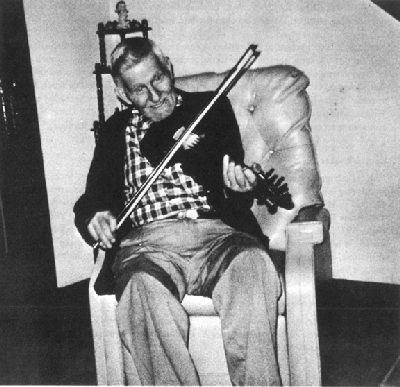
Quince Dillon's High D
From the playing of Henry Reed
Quince Dillon’s High D is a tune commonly thought to have been taught to fiddler Henry Reed (1884-1968) of Glen Lyn, Virginia, by a Civil War fifer named Quincey Dillion. This tune was collected from Reed in 1967 by researcher Alan Jabbour. The “thought to have been” comes into play due to a lack of verifiable documentation combined with the declining memory of Reed. When Jabbour collected this tune, Reed did not remember the tune’s actual name, saying only that he learned it from Dillion. Apparently, Jabbour’s notes did not help much because, according to The Library Of Congress from their Alan Jabbour project files, “This tune cannot be traced to other sources. It somehow came to be thought of as a tune Henry Reed learned from Quince Dillion, though there is no concrete evidence of this in the field notes from the 1960s, and it has gone back into circulation among some performers in the old-time music revival under the title "Quince Dillion's High-D Reel," the title used here.”
Multiple sources opine that this is the only surviving tune passed down from Dillion, but Jabbour reports that Henry Reed learned other tunes from Quince Dillion, including “British Field March.” During a 1967 interview with Alan Jabbour, Reed also confirms playing many of Dillon’s tunes and adds, “He was a good fiddler…he could play a fast tune...he could play most anything…” (at about 1:08 in the interview)
The written notes from that interview lists brothers Elbert (Eb) and John Dillion, along with their uncle Quince, as older fiddlers Reed learned tunes from as a boy. Reed added, "One of them, I can’t remember who, played a fife, too."
Jabbour seemingly embraces the mystique of Quince Dillion as part of his 2012 comments to Old Time Party saying, “...they occasionally even tease me that either I or Henry Reed might have just made him up…”
Quince Dillion was, however, a real person and a Civil War fifer. His full name was Quincie Perry Dillion, also known as “Uncle Quincy.” His date of birth in Franklin County, VA is variously reported as between 1810 and 1827. He died in 1901 in Monroe County WV, and is buried there. As can be seen by the listings of various family members on his Find A Grave page, the Dillion name is also commonly spelled “Dillon.” Quince, Quincy, and Quincey are common spellings of his first name.
According to a researcher quoted on the ibiblio website, Dillion’s military records show that he volunteered for service as a fife player in the 166th Virginia Militia in August, 1861. ed.note: That date would have made him anywhere from 34-51 years old at the time, certainly not the stereotyped young boy fifer we often see in the movies. The 166th was later incorporated into the 59th Virginia Militia, and that unit was captured during the battle of Roanoke Island, NC. According to another researcher, members of the 59th who either escaped, or were later paroled, reorganized as the 26th Virginia Battalion. Records there show that Dillion re-enlisted in 1863, and was promoted to Chief Musician. Interestingly, according to the bio page of a relative who owns Dillon’s Music in New Jersey, musicians in the Dillon family can be documented back to the 1700s. They also relate that “Uncle Quince” was an accomplished fiddler.
As mentioned in the notes from the Library of Congress, the tune was picked up and named by players during the folk/old time music revival. The Fuzzy Mountain String Band helped further popularize it by inclusion on their 1973 “Summer Oaks & Porch” album.
As expected, Quince Dillon’s High D is played in the key of D. The tune features a high D note on the fiddle’s E string, the signature sound that gives this previously untitled melody its name. Remembering that Dillion was a fifer, it is interesting (in a fife trivia way) to note that traditional fifes are not chromatic instruments, limiting the keys in which they realistically can be played. However, fife music notation is commonly written as if the fife is in the key of D. The important part for us is that this was thought to have been adopted for shared repertoire and ease of playing with fiddlers.
Quince Dillon's High D is most commonly played in two parts, probably because that was the way Henry Reed played it when collected by Jabbour. However, Reed’s son James tells us that his father normally played the tune with four parts, but only played two parts on the field recording that is in the Library of Congress. Alan Jabbour later recorded the four part version, accompanied by James Reed, on the 2002 album “A Henry Reed Reunion.” Written notation of the four part version is in the photo slider, and Jabbour’s four part recording is in the mp3 player below. Besides the playing of two or four parts, there are also group and regional differences as to which A or B part gets played first.
On his website’s “About The Tune” section, Dan Levinson writes, “We often refer to it in jest as Quince Dillon’s High C# because it takes a bit of work (dare I say practice?) to get that high D note on the E string just right!”
No matter the order in which the parts are played, or whether you play two or four parts, like Dan says, “Just get up to that high D!”
Quince Dillon's High D
Jane Rothfield 2010
Quince Dillon's High D Tune
Chris Coole, Alan Jabbour, and Mac Benford
at Midwest Banjo Camp 2013
(tune starts at 1:12)
Quince Dillon's High D
Fuzzy Mountain String Band
1972
7/18/25





